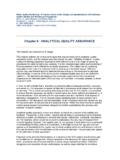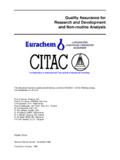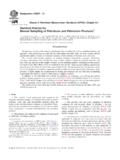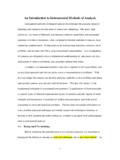Transcription of 9 QUALITY ASSURANCE AND QUALITY CONTROL …
1 9 quality assurance and quality control Introduction The goa l of QUALITY ASSURANCE and QUALITY CONTROL (QA/QC) is to identify and implement sampling and analytical methodologies which limit the introduction of error into analytical data. For MARSSIM data collection and evaluation, a system is needed to ensure that radiation surveys produce results that are of the type and QUALITY neede d and expected for their intended use. A QUALITY system is a management system that describes the elements necessary to plan, implement, and assess the effectivene ss of QA/QC activities. This system establishes many functions including: QUALITY management policies and guidelines for the development of organization- and project-specific QUALITY plans; criteria and guidelines for assessing data QUALITY ; assessments to ascertain effectiveness of QA/QC implementation; and training programs related to QA/QC implementation. A QUALITY system ensures that MARSSIM decisions will be supported by sufficient data of ade quate QUALITY and usability for their intended purpose, a nd further ensures that such data are authentic, appropriately documented, and technically defensible.
2 Any organization collecting and evaluating data for a particular program must be concerned with the QUALITY of results. The organization must have results that: meet a well-defined need, use, or purpose; comply with program requirements; and reflect consideration of cost and economics. To meet the objective, the organization should CONTROL the technical, administrative, and human factors affecting the QUALITY of results. CONTROL should be oriented toward the appraisal, reduction, elimination, and prevention of deficiencies that affect QUALITY . QUALITY systems already exist for many organizations involved in the use of radioactive materials. There are self-imposed internal QUALITY management systems ( , DOE) or there are systems required by regulation by another entity ( , NRC) which require a QUALITY system as a condition of the operating These systems are typically called QUALITY ASSURANCE Programs. An organization may also obtain services from another organization that already has a QUALITY system in place.
3 When developing an organization-specific QUALITY system, there is no need to develop new QUALITY management systems, to the extent that a facility s current QUALITY ASSURANCE Program can be used. Standard ANSI/ASQC E4-1994 (ASQC 1995) provides national consensus QUALITY standards for environmental programs. It addresses both QUALITY systems and the collection and evaluation of environmental data. Annex B of ANSI/ASQC E4-1994 1 Numerous QUALITY ASSURANCE and QUALITY CONTROL (QA/QC) requirements and guidance documents have been applied to environmental programs. Until now, each Federal agency has developed or chosen QA/QC requirements to fit its particular mission and needs. Some of these requirements include DOE Order (DOE 1991c); EPA QA/R-2 (EPA 1994f); EPA QA/R-5 (EPA 1994c); 10 CFR 50, App. B; NUREG-1293, Rev. 1 (NRC 1991); Reg Guide (NRC 1979); and MIL-Q-9858A (DOD 1963). In addition, there are several consensus standards for QA/AC, inc luding ASME NQA-1 (ASME 1989), and ISO 9000/ASQC Q9000 series (ISO 1987).
4 ANSI/ASQC E4-1994 (ASQC 1995) is a consensus standard specifically for environmental data collection. August 2000 9-1 MARSSIM, Revision 1 QUALITY ASSURANCE and QUALITY CONTROL (ASQC 1995) and Appendix K of MARSSIM illustrate how existing QUALITY system documents compare with organization- and project-specific environmental QUALITY system documents. Table illustrates elements of a QUALITY system as they relate to the Data Life Cycle. Applying a QUALITY system to a project is typically done in three phases as described in Section : 1) the planning phase where the Data QUALITY Objectives (DQOs) are developed following the process described in Appendix D and documented in the QUALITY ASSURANCE Project Plan (QAPP),2 2) the implementation phase involving the collection of environmental data in accordance with approved procedures and protocols, and 3) the assessment phase including the verification and validation of survey results as discussed in Section and the evaluation of the environmental data using Data QUALITY Assessment (DQA) as discussed in Section and Appendix E.
5 Detailed guidance on QUALITY systems is not provided in MARSSIM because a QUALITY system should be in place and functioning prior to beginning environmental data collection activities. Table The Elements of a QUALITY System Related to the Data Life Cycle Data Life Cycle QUALITY System Elements Planning Data QUALITY Objectives (DQOs) QUALITY ASSURANCE Project Plans (QAPPs) Standard Operating Procedures (SOPs) Implementation QAPPs SOPs Data collection Assessment s and audits Assessment Data validation and verification Data QUALITY Assessment (DQA) A graded approach bases the level of controls on the intended use of the results and the degree of confidenc e neede d in their QUALITY . Applying a grade d approach may mean that some organizations ( , those using the simplified procedures in Appendix B) make use of existing plans and procedures to conduct surveys. For many other organizations, the need for cleanup and restoration of contaminated facilities may create the need for one or more QAPPs suitable to the special needs of environmental data gathering, especially as it relates to the demonstration of compliance with regulatory requirements.
6 There may even be a need to update or revise an existing QUALITY management system. 2 The QUALITY ASSURANCE project plan is sometimes abbreviated QAPjP. MARSSIM adopts the terminology and abbreviations used in ANSI/ASQC E4-1994 (ASQC 1995) and EPA QA/R-5 (EPA 1994c). MARSSIM, Revision 1 9-2 August 2000 QUALITY ASSURANCE and QUALITY CONTROL Development of a QUALITY ASSURANCE Project Plan The QUALITY ASSURANCE Project Plan (QAPP)3 is the critical planning document for any environmental data collection operation because it documents how QA/QC activities will be implemented during the life cycle of a project (EPA 1997a). The QAPP is the blueprint for identifying how the QUALITY system of the organization performing the work is reflected in a particular project and in associated technical goals. This section provides information on how to develop a QAPP based on the DQO process. The results of the DQO process provide key inputs to the QAPP and will largely determine the level of detail in the QAPP.
7 The consensus standard ANSI/ASQC E4-1994 (ASQC 1995) describes the minimum set of QUALITY elements required to conduct programs involving environmental data collection and evaluation. Table lists the QUALITY elements for collection and evaluation of environmental data from ANSI/ASQC E4-1994. These QUALITY elements are provided as examples that should be addressed when developing a QAPP. This table also includes references for obtaining additional information on each of these QUALITY elements. Many of these elements will be addressed in existing documents, such as the organization s QUALITY ASSURANCE Program or QUALITY Management Plan. Each of these QUALITY elements should be considered during survey planning to determine the degree to which they will be addressed in the QAPP. Additional QUALITY elements may need to be added to this list as a result of organizational preferenc es or requirements of Federal and State regulatory authorities. For example, safety and health or public participation may be included as elements to be considered during the development of a QAPP.
8 The QAPP should be developed using a graded approach as discussed in Section In other words, existing procedures and survey designs can be included by reference. This is especially useful for sites using a simplified survey design process ( , surveys designed using Appendix B). A QAPP should be developed to document the results of the planning phase of the Data Life Cycle (see Section ). The level of detail provided in the QAPP for relevant QUALITY elements is determined using the DQO process during survey planning activities. Information that is already provided in existing documents does not need to be repeated in the QAPP, and can be included by reference (EPA 1997a). 3 MARSSIM uses the term QUALITY ASSURANCE Project Plan to describe a single document that incorporates all of the elements of the survey design. This term is consistent with ANSI/ASQC E4-1994 (ASQC 1995) and EPA gui da nc e (EPA 1994c, EPA 1997a), and is recommended to promote consistenc y.
9 The use of the term QAPP in MARSSIM does not exclude the use of other terms ( , Decommissioning Plan, Sampling and Analysis Plan, Field Sampling Plan) to describe survey planning documentation as long as the information in the documentation supports the objectives of the survey. August 2000 9-3 MARSSIM, Revision 1 QUALITY ASSURANCE and QUALITY CONTROL Table Examples of QAPP Elements for Site Surveys and Investigations QAPP Element Information Source Planning and Scoping (reference the QA Manual for information on the QUALITY system) ASQC 1995 EPA 1994c EPA 1997a NRC 1997c EPA 1993d Part A, Sections and ; Part B, Section Sections A4, A5, A6 and A7 Chapter III, Sections A4, A5, A6, and A7 Chapter 14 Project Obj ectives Design of Data Collection Operations (including training) ASQC 1995 EPA 1994c EPA 1997a EPA 1993d Part A, Section ; Part B, Section Sections A9 and B1 Chapter III, Sections A9 and B1 Sampl ing Design Implementation of Planned Operations (including documents and records) ASQC 1995 EPA 1994c EPA 1997a NRC 1997c EPA 1993d Part A, Section.
10 Part B, Section Sections A1, A2, A3, B2, B3, B4, B5, B6, B7, B8, B9, and B10 Chapter III, Sections A1, A2, A3, B2, B3, B4, B5, B6, B7, B8, B9, and B10 Chapter 5 Sampling Execution, Sample Analysis Assessment and Response ASQC 1995 EPA 1994c EPA 1997a EPA 1993d Part A, Section , Part B, Section Sections C1 and C2 Chapter III, Sections C1 and C2 Exhibit 3, Reference Box 3 Assessment and Verification of Data Usability ASQC 1995 EPA 1994c EPA 1997a NRC 1997c EPA 1993d Part B, Section Sections D1, D2, and D3 Chapter III, Sections D1, D2, and D3 Chapter 20, Appendix J, Appendix Q Assessment of Data QUALITY For example, the QUALITY system description, personnel qualifications and requirements, and Standard Operating Procedures (SOPs) for the laboratory analysis of samples may simply be references to existing documents ( , QUALITY Management Plan, Laboratory Procedure Manual). SOPs for performing direct measurements with a specific instrument may be attached to the QAPP because thi s information may not be readily available from other sources.
















